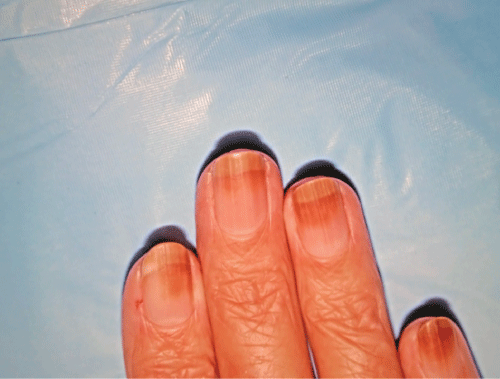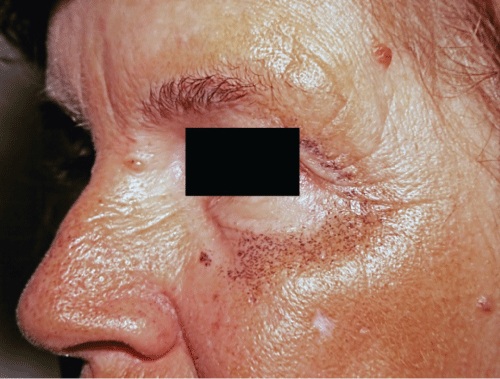Journal of Dermatology Research and Therapy
Exogenous Ochronosis with Use of Low Potency Hydroquinone in A Caucasian Patient
Luke Maxfield1* and David A. Gaston2,3
1Lake Erie College of Osteopathic Medicine, USA
2Dermatology & Laser Center, Medical Center Clinic, USA
3Florida State University College of Medicine, USA
*Corresponding author:
Luke Maxfield, OMS3, Lake Erie College of Osteopathic Medicine, 8917 North Davis Hwy Apt 112, Pensacola, FL 32514, USA, Tel: 719-201-3373, E-mail: luke.maxfield@med.lecom.edu
J Dermatol Res Ther, JDRT-1-003, (Volume 1, Issue 1), Case Report; ISSN: 2469-5750
Received: May 02, 2015 | Accepted: May 28, 2015 | Published: May 30, 2015
Citation: Maxfield L, Gaston DA (2015) Exogenous Ochronosis with Use of Low Potency Hydroquinone in A Caucasian Patient. J Dermatol Res Ther 1:003. 10.23937/2469-5750/1510003
Copyright: © 2015 Maxfield L, et al. This is an open-access article distributed under the terms of the Creative Commons Attribution License, which permits unrestricted use, distribution, and reproduction in any medium, provided the original author and source are credited.
Abstract
Exogenous ochronosis is a rare condition of paradoxical skin darkening seen with use of the skin lightening agent hydroquinone. Incidence has been highest in patients with darker skin types, prolonged use, and higher concentration treatment, but has been reported with low dose (2%) as well. Here we present a rare case of exogenous ochronosis, with resultant skin and nail hyperpigmentation, occurring in a Caucasian female using 3% hydroquinone cream over an eighteen-month period.
Keywords
Exogenous, Ochronosis, Nail hyperpigmentation, Hydroquinone, Caucasian
Introduction
Exogenous ochronosis is a rare condition that presents as maculopapular paradoxical hyperpigmentation seen after use of skin lightening agents containing hydroquinone. Most cases have been seen in patients with darker skin types with prolonged use of high potency topicals. We however, present a Caucasian patient who developed exogenous ochronosis after 18 months use of a non-prescription 3% strength hydroquinone cream. Treatment for this condition is difficult and thus physician awareness with early recognition and discontinuation is paramount to limiting what may progress to permanent discolorations.
Case Report
A 53 year old Caucasian lady presented complaining of an asymptomatic eruption of tiny grey-black maculopapules around her eyes (Figure 1). This condition had been present and gradually worsening for about a year. She denied any skin lesions like this elsewhere, but had noted an orange-brown discoloration of her fingernails the past six months (Figure 2). She enjoyed excellent general health and past medical history was non-contributory. Questioning about topical hygiene and cosmetic product use revealed that she had been using a non-prescription 3% hydroquinone cream to lighten "dark circles" under her eyes for about eighteen months. A punch biopsy was taken of the periorbital speckles. Pathology showed the dermis to have scattered yellow-orange-brown (so called "ochre colored") particles, some with a banana shape and many with an angulated, fractured glass appearance. A diagnosis of exogenous ochronosis was made. Attempts to find an effective laser to non-ablatively resolve this condition were made by treating small test areas with the following lasers using various fluences and spot sizes: 585 nm and 595 nm pulsed dye laser, Q-switched Nd: YAG laser at 1064 nm and 532 nm, and Q-switched 755 nm Alexandrite laser. All of these tests failed to show improvement. We planned to next try fractionated CO2 and Er:YAG laser lasers, but the patient refused and was then lost to follow-up.

.
Figure 2: This nail hyperpigmentation is noted to be on the top surface of the nails
View Figure 2
Discussion
Ochronosis is a rare condition resulting from deposition of homogentisic acid into the dermis of the skin [1,2]. There are two types of ochronosis, exogenous ochronosis being distinct from endogenous ochronosis or alkaptonuria.
Endogenous ochronosis is a rare autosomal recessive metabolic disorder in which homogentisic acid oxidase is deficient. Homogentisic acid is broken down by the enzyme homogentisic acid oxidase and is a hydroquinone metabolite of tyrosine. With decreased enzyme activity, the excess homogentisic acid irreversibly binds to dermal fibrillar collagen, which results in skin pigmentation [3], cartilage deposition, and darkening of the urine after prolonged exposure to air. After the fourth decade of life the major manifestation is osteoarthritis, but multiple other body systems; including the heart, musculature, genitourinary, eyes, and ears are also involved. Diagnosis of alkaptonuria is suspected by clinical history and characteristic urine changes, with the gold standard of diagnosis being confirmation of homogentisic acid in the urine [4].
The incidence of exogenous ochronosis is rare in the United States, with less than 25 reports from 1985 to 2010. This reported incidence suggested one case per 300-450 million units of hydroquinone sold in the U.S. [5]. Worldwide, the largest population affected has been South-African blacks, being described in up to 35% of the population. This report was thought directly related to high concentrations of hydroquinone in bleaching creams prior to 1984. It is important to note that this reaction can occur in any patient regardless of skin type. Exogenous ochronosis is most commonly seen after use of skin lightening agents containing hydroquinone, but a similar-appearing condition has also been reported after contact with resorcinol, phenol, mercury, picric acid, and use of antimalarials [6]. Use of hydroquinone has been part of treatment for both post inflammatory hyperpigmentation and melasma for years [7,8]. Use of hydroquinone for melasma is maintained for prolonged periods and shows improved efficacy with higher dose (4% or greater). Incidence of exogenous ochronosis is directly related to both dose and duration of use, although occurrence with 2% topical hydroquinone treatment has provided emphasis of duration more than dosage [3]. Involvement of exogenous ochronosis is limited to skin after direct topical exposure and grossly appears as symmetric, hyperchromic, blue-gray macules and papules in sun-exposed areas [9]. This distribution is likely secondary to mechanisms, though speculated, of locally inhibited enzymes of homogentisic acid metabolism (i.e. homogentisic acid oxidase or tyrosinase) [1].
The differential diagnosis with hyperpigmented macules as seen with exogenous ochronosis can be extensive, including melasma, bilateral nevus of Ota, hyperpigmentation from other drugs (e.g., minocycline, methotrexate, or amiodarone), post inflammatory hyperpigmentation, and dermatosis papulosa nigra. As patients with exogenous ochronosis may also have melasma, a very clear history including exposures and treatments is imperative [10]. Diagnosis by non-invasive dermoscopy and reflectance confocal microscopy (RCM) has been shown to be reliable in making the diagnosis of exogenous ochronosis from the list of differentials. By dermoscopy, lesions appear as dark brown globules and globular like structures on a diffuse brown background. Features of exogenous ochronosis seen by RCM are dark, well-defined, round-to-oval and dermal banana shaped structures, the latter finding being more specific as it had not been attributed to any previous cutaneous structure or disease. Diagnosis can be confirmed by skin biopsy, yielding characteristic yellow-brown, banana-shaped fibers within the papillary dermal layer with or without sarcoidal granulomas or multinucleated giant cells [10].
The orange-brown nail pigmentation shown by our patient has also been noted previously in patients using hydroquinone creams. It is reportedly a result of oxidation of hydroquinone which has contacted the nails, and resolves as the nails grow out as long as further contact with hydroquinone is minimized. This side effect can be prevented by taking care to avoid nail contact with the product and by good hand washing after application [11].
Treatment of this condition is difficult and no individual therapy has been shown to be definitively curative [1,6]. Due to these difficulties, prevention is imperative and use of the lowest effective dose of hydroquinone concentrations with sun protection and early diagnosis may alter the outcome [6]. The first step is to remove the inciting agent. While trichloroacetic acid and cryotherapy are ineffective, other medical treatments report varied success. Retinoic acid has shown to improve discoloration for some patients; however, it has also been reported to cause hyperpigmentation in others. High SPF sunscreen in combination with retinoic acid or low potency corticosteroids has also shown some success, and oral tetracycline reportedly successfully treated one patient. Further treatment involves a series of superficial, ablative modalities in hopes of removing the pigment deposition without causing scarring. Methods include chemical peels, CO2 laser, cryotherapy, dermabrasion, and fractional carbon dioxide and erbium-YAG lasers [1].
In summary, despite hydroquinone being an effective treatment for multiple dyschromias, its use is associated with the rare complication of exogenous ochronosis. Patients using hydroquinone agents should be warned of this potential side effect and monitored regularly as treatment is limited and early discontinuation of the offending agent is central to the long-term outcome of exogenous ochronosis [1].
References
-
Levin CY, Maibach H (2001) Exogenous ochronosis. An update on clinical features, causative agents and treatment options. Am J Clin Dermatol 2: 213-217.
-
Merola JF, Meehan S, Walters RF, Brown L (2008) Exogenous ochronosis. Dermatol Online J 14: 6.
-
Gandhi V, Verma P, Naik G (2012) Exogenous ochronosis After Prolonged Use of Topical Hydroquinone (2%) in a 50-Year-Old Indian Female. Indian J Dermatol 57: 394-395.
-
Craide FH, Fonseca JS, Mariano PC, Fernandez NM, Castro CG, et al. (2014) Alkaptonuria--case report. An Bras Dermatol 89: 799-801.
-
Talakoub L, Wesley N (2010) Hydroquinone: Complications and Controversies. Dermatology News.
-
Martins VM, Sousa AR, Portela Nde C, Tigre CA, Gonçalves LM, et al. (2012) Exogenous ochronosis: case report and literature review. An Bras Dermatol 87: 633-636.
-
Davis EC, Callender VD (2010) Postinflammatory hyperpigmentation: a review of the epidemiology, clinical features, and treatment options in skin of color. J Clin Aesthet Dermatol 3: 20-31.
-
Ennes SBP, Paschoalick RC, Mota de AvelarAlchorne M (2000) A double-blind, comparative, placebo-controlled study of the efficacy and tolerability of 4% hydroquinone as a depigmenting agent in melasma. Journal of Dermatological Treatment 11: 173.
-
Mishra SN, Dhurat RS, Deshpande DJ, Nayak CS (2013) Diagnostic utility of dermatoscopy in hydroquinone-induced exogenous ochronosis. Int J Dermatol 52: 413-417.
-
Gil I, Segura S, Martínez-Escala E, Lloreta J, Puig S, et al. (2010) Dermoscopic and reflectance confocal microscopic features of exogenous ochronosis. Arch Dermatol 146: 1021-1025.
-
Garcia RL, White JW Jr, Willis WF (1978) Hydroquinone nail pigmentation. Arch Dermatol 114: 1402-1403.






